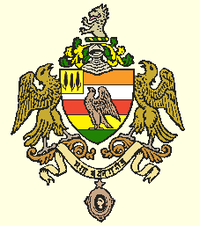Loading AI tools
North Indian dynasty From Wikipedia, the free encyclopedia
The Rathore dynasty or Rathor dynasty was an Indian dynasty belonging to the Rathore clan of Rajputs that has historically ruled over parts of Rajasthan, Gujarat and Madhya Pradesh.[1][2][3][a]
| Rathore dynasty House of Marwar | |
|---|---|
 | |
 Flag of Jodhpur | |
| Parent house | Gahadavala dynasty |
| Country | Jodhpur State |
| Founded | 1226 |
| Founder | Rao Siha |
| Current head | Gaj Singh |
| Final ruler | Hanwant Singh |
| Titles | Raja of Marwar Raja of Jodhpur |
Jodha, Vadhel, Jaitawat, Kumpawat, Champawat, Mertiya, Bikawat, Udawat, Karamsot, etc. are the branches or subclans of Rathore Rajputs.[5]
This article discusses the "Kanaujiya" Rathores of Marwar and lineages, thereof; Norman Ziegler had noted of 12 other similar branches ("shakhas") of Rathores — Sur, Shir, Kapaliya, Kherada, Abhepura, Jevamt, Vagula, Karaha, Parakra, Ahrao, Jalkheda, and Camdel.[6] Scholarship about those branches are scarce to non-existent.[6]
A section of historians argue for a Rashtrakuta origin.[7][8] Branches of Rashtrakutas had migrated to Western Rajasthan as early as late tenth century; multiple inscriptions of "Rathauras" have been located in and around Marwar dating from tenth to thirteenth century; the Rathores may have emerged from one of the Rashtrakuta branches.[7]
Muhnot Nainsi, employed by the Rathores of Marwar, chronicled Nainsi ri Khyat, a bardic genealogical history of the Rajputs in western Rajasthan c. 1660; one of the oldest extant historical records of the region, the Khyata collated information from existing oral literature, genealogies and administrative sources in a chronological fashion.[4][page needed][7][9][b][c] Nainsi had noted of the Rathores to have originated from Kannauj before migrating to Marwar.[4]
British indologist V. A. Smith theorized that the Rathores and Bundelas are offshoot of the Gahadavala dynasty.[10] Roma Niyogi considers this claim to be of a later origin.[11]
These bardic claims of descent have been since deemed to be largely ahistorical by Ziegler.[7][d] Ziegler notes the theme of migrations to be common across Rajput genealogies; a construct, borrowed from literary canon of other regions.[7] Later genealogies of Rathores went as far as to derive origin from Gods of the Hindu pantheon — Indra, Narayana et al.[4][e]

The first Rathore chieftain was Siho Setramot, grandson of the last Gahadavala king Jayachandra.[4][f] Setramot abdicated the throne of Kanauj to become an ascetic but got embroiled in a royal rivalry and eventually married the daughter of a Gujarati ruler, who birthed him three sons.[4][7] Asthan, the eldest, was raised at Paltan after Siho's death (at Kanauj) and he went on to establish the first Rathore polity in Pali (and few adjoining villages), after winning over the local Brahmins by defeating an oppressive king named Kanha Mer.[4] Other contemporary sources claim the same descent and construct slightly variable narratives about migration from Kanauj: Setramot fled the Ghurid Sultanate to Marwar and established the first Rathore polity.[8][7][13] The Bithoor inscription provides the date of Siho's death in 1273 CE and calls him the son of Set Kunwar; however, it does not claim any Gaharwal origin.[g]
Under Asthan's regime, and that of his successor-rulers, the Rathore territories significantly expanded courtesy confrontations and diplomatic negotiations with other pastoral groups; the primary base shifted multiple times.[4][h] Marital alliances with any warrior-group operating out of Thar were especially favored and they were welcome to be inducted in the Rathore fold.[4][i] Multiple new Rathore branches seem to have split out in these spans.[12][j]
The precise accuracy of events which allegedly occurred across these spans is questionable and may not be relied upon except for a generic reconstruction.

Chunda, who was ninth in descent from Asthan, married a Pratihara princess and was gifted the territory of Mandore as a dowry by the Pratihara clan. In return Chunda promised to defend Mandore against the Tughlaq Empire.[14] Mandore thus became the new capital of the Rathore clan, c. 1400.[4][page needed] This prompted a significant sociopolitical shift: the hitherto nomadic lifestyle frequented with cattle raids etc. would gradually give way to landed aristocracy.[4][k] His son Ranmal was assassinated in 1438; Marwar was annexed by Sisodias whilst other parts were captured by Delhi Sultanate.[4][l]
In 1453, Rao Jodha regained Marwar, and expanded his territories by entering into multiple alliances with fellow Rajputs; the Jodha line was established with his consecration of a new capital at Jodhpur. Rao Jodha was successful in annexing several territories from the Delhi Sultanate, due to which the Rathores of Marwar became the most powerful kingdom in Rajputana during his reign. [15] Among his sons, Rao Bika found a new state in Bikaner in 1465; he and his successors would go on to expand territories therefrom, adopting similar tactics.[4] This Bikawat branch became the new bearer of Rathore legacy, even bringing Gahdavala-time emblems and heirlooms from Marwar.[4] Another of Jodha's sons Rao Varsingh found a new state at Merto in 1462, establishing the Mertiyo branch.[4][16]
Rao Maldeo's regime (1532-1562) harbored another significant shift from clannish rule to monarchy; Malde forced his distant relatives, who conquered new territories, to submit to him or else be deprived of gains.[4] Bikaner was raided, too.[4] Large palaces were constructed and fortifications were committed to, in what signaled the effective end of pastoral lifestyle.[4] By mid-sixteenth century, the Rathors had a firm hold over entire Rajasthan.[4]
All these while, multiple matrimonial and military alliances with local Islamic kingdoms; the Delhi Sultanate have been noted; Hindu-Muslim relations were largely fraternal.[6][m]

The situations deteriorated once Akbar was ordained as the Mughal Emperor, and rao Maldeo died. His son rao Chandrasen Rathore defended his kingdom for nearly two decades against relentless attacks from the Mughal Empire.[4] The Jodhawat Rathores lost much of their territory rapidly and were effectively subsumed.[4] The Bikawat Rathores entered into friendly relations with the Mughals, led their armies, and were extensively patronaged to the extent of being allowed to control the Jodhpur Fort.[4] In 1583, Uday Singh finally accepted Mughal suzerainty and in return, was granted part of a Pargana in Jodhpur; this would enable the Jodhawat Rathores to become all-weather allies of the Mughals though punctuated with discords.[4]
This span of cohabitation led to the introduction of strict endogamy into Rathore folds and hypergamy with Mughals.[4] It was also under the Mughals, that bardic genealogies were crafted to present themselves as worthy appointees of the Mughals and distinguish themselves from other "once-fraternal" communities, thereby staking a claim to power irrespective of temporal situations.[4][7][9] Also, by this time, the nomadic memories were better suppressed and the Rathores had themselves rebranded as the elite "protectors" of local cattle-rearers; in a couple of centuries, figures from early Rathore polity would be deified.[4]
Many scions of the Rathore clan were able to establish their own kingdoms during the Mughal reign. Barbara Ramusack notes how a 23-year-old Ratan Singh Rathore, who was from a younger branch of the Jodhpur ruling family, was able to rise in rank by fighting against a mad elephant in Delhi. Shah Jahan was so impressed by his valour that he enlisted Ratan Singh in his army. Ratan Singh was able to rise to a rank of 3,000, received the Mahi-Maratib and Jagirs in Malwa, where he founded his own kingdom in Ratlam. The dynasty started by Ratan Singh would further breakaway and form the kingdoms of Sailana and Sitamau.[17]
During Aurangzeb's reign major rebellions would break out resulting in a 30 year war between the Mughals and the Rathores. The rebellion would continue until Bahadur Shah I's reign. Durgadas Rathore played an instrumental role in protecting the Rathore dynasty of Jodhpur during this war.[18][19]
The Rathore ruler of Jodhpur Man Singh, initially refused to form treaties with the British. However in 1805-1806 he approached the British for military advice and paid the British to protect his state against the predatory actions of the Marathas and Pindaris. By 1816 the British changed this treaty and expelled all foreign influence in Jodhpur, they also started arbitrating in state matters. By 1818 the alliance was cemented and in 1832 the Rajputana agency was formed.[4] Man Singh was not always cordial with the British during this time, in 1829 Man Singh gave shelter to Mudhoji II Bhonsle and antagonized the British. Mudhoji was zealously protected by Man Singh and lived his remaining life in Jodhpur till his death in 1840.[20] Man Singh was finally caught with evidence, when his spy Dhumdas was arrested by the British. Man Singh was using ascetics as spies and messengers. The letters proved that Man Singh was part of an "anti-British cabal" which included Maharaja Ranjit Singh of Punjab, Dost Muhammad, King of Afghanistan and the Russians. In September 1839 the British sent an army and captured Jodhpur. Man Singh chose to relinquish his throne and became an ascetic to avoid war. The exiled maharaja of Jodhpur died on 5 September 1843 due to poor health.[21] The 1857 rebellion sparked uprisings amongst several Rajput chieftains of the Rathore clan in Jodhpur State. Prominent amongst them was Kushal Singh of Auwa. After several failed attempts by the British, the rebellion was quelled by the British army under the command of Brigadier Holmes.[22]
During the 20th century the lower castes in India tried to uplift their social standing by adopting surnames of other castes. The Rajput clan name "Rathore" was adopted as a surname by the Teli community in 1931, who started calling themselves Vaishyas Rathore for caste upliftment.[23] During the same period of British Raj, the Banjaras began styling themselves as Chauhan and Rathor Rajputs.[24]

The various cadet branches of the Rathore clan gradually spread to encompass all of Marwar and later founded states in Central India and Gujarat. The Marwar Royal family is considered the head house of Rathores. At the time of India's independence in 1947, the princely states ruled by various branches of the Rathore clan included:[25][1]
Seamless Wikipedia browsing. On steroids.
Every time you click a link to Wikipedia, Wiktionary or Wikiquote in your browser's search results, it will show the modern Wikiwand interface.
Wikiwand extension is a five stars, simple, with minimum permission required to keep your browsing private, safe and transparent.